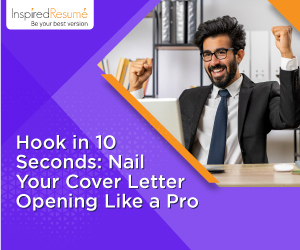In job applications, the advice to “stand out from the crowd” is more than a matter of eye-catching designs or catchy phrases; it’s about building a genuine connection. Each job is a unique doorway, and your resume and cover letter act as your introduction, your first impression. Instead of sending a generic application, make an effort to tailor and create your resume specifically for each role. This shows respect for the job, enhances your fit for the role, and demonstrates genuine interest. Such an approach can transform your application from one of many into a powerful statement of purpose and fit. Let’s explore how to master this art and make a lasting impression.
Get a customized cover letter. INSTANTLY
1. Understand the Role Beyond the Job Description
Every job listing gives a glimpse into what the company values in a candidate. Go beyond these descriptions by researching the organization’s website, exploring any recent news, and understanding its goals and challenges. Identify the core responsibilities and key qualifications but also consider the “soft skills” and cultural fit. If the company emphasizes teamwork and flexibility, make sure those traits appear in your cover letter and are reflected in your resume’s words.
By using the right resume words or keywords, you ensure your application is both relevant and resonant with the company’s goals. This approach helps you align your skills with the job and ensures you avoid sounding like a template applicant. It also makes your conversations with the company richer if you get to the interview stage, as you will be more attuned to their goals and challenges.
2. Highlight Relevant Achievements for Impact
Recruiters want to see concrete examples of work that directly relate to the role they are filling. Generic achievements may impress, but they don’t always resonate if they are irrelevant to the job. Prioritize achievements relevant to the position.
For example, if you are applying for a marketing role, highlight campaigns or projects where you demonstrated creativity and achieved measurable results. Rather than listing every accomplishment, emphasize those that show you already have experience handling challenges the new role might involve.
3. Match Keywords Naturally
Today, many organizations use Applicant Tracking Systems (ATS) to filter candidates based on keywords. Incorporating these keywords effectively is essential when you create your resume, ensuring it reaches human eyes. There is a fine line, however, between matching keywords and sounding like a buzzword machine. Be mindful of the job’s keywords, and make sure they fit organically into your descriptions.
Read the job description carefully and create your resume finding resume words that relate to both hard and soft skills. Terms such as “data analysis” or “project management” might reflect hard skills, while “collaboration” or “adaptability” capture soft skills. Then, integrate these terms naturally into your bullet points or summary. The key is to maintain content flow while matching essential terms.
How to add metrics to your resume for maximum impact
4. Personalize Your Cover Letter to Reflect Passion and Fit
While the resume shows your skills and experience, the cover letter brings in the human element. A personalized cover letter demonstrates that you took the time to consider why you are excited about this role. Start by addressing the hiring manager by name, if possible, and open with why you feel drawn to the role and company.
In the body, share a specific example of how your background aligns with their goals. For instance, if the company is focused on innovation and you have experience in implementing new processes, mention that. Closing with a few words about shared values can also leave a memorable impression.
Get a customized cover letter. INSTANTLY
5. Adapt Your Tone to Fit the Company Culture
A resume is often seen as formal, while the cover letter can have a bit more personality. If applying to a corporate finance firm, a traditional tone will probably be most effective. For a startup with a relaxed vibe, a touch of conversational language can make your application feel more at home. This doesn’t mean adopting a casual tone if it doesn’t feel authentic; it’s about ensuring that your application mirrors the company’s values and workplace style.
For instance, if a company describes itself as “fast-paced and innovative,” use active language when you create your resume to reflect that energy. If the organization prides itself on collaboration, your cover letter should highlight examples where you worked closely with others to solve a problem or achieve a goal.
6. Streamline Your Resume for Clarity and Brevity
A tailored resume doesn’t need to be long. In fact, the more you customize it, the more likely it is to be succinct. Eliminate experiences and skills that are irrelevant to the role you are applying for, and keep your points focused on the most impactful parts of your experience. Each line should serve a purpose and contribute to the story you are trying to tell: that you are a strong match for this position.
When selecting resume words to emphasize, focus each section on just one or two standout achievements that connect back to the job description. Focus each section on one or two standout achievements that connect back to the job description. This approach makes it easier for the reader to understand your strengths and demonstrates your ability to communicate concisely.
7. Showcase Continuous Learning and Adaptability
If there is one quality every employer values, it’s the ability to adapt and grow. In a rapidly changing world, this is more important than ever. Consider including recent courses, certifications, or self-driven projects that reflect a commitment to staying current in your field. Mentioning these in your resume or cover letter shows that you are forward-thinking and proactive about your development.
This is especially valuable if you are transitioning into a new industry or role. Highlight how your past experiences coupled with your recent learning make you a well-rounded candidate for the position.
8. Proofread and Get Feedback
Tailoring your resume and cover letter is not just about the big picture; it’s also about getting the details right. One small typo or awkward phrase can affect the overall impression. After crafting your materials, take a break and return with fresh eyes to catch any issues you might have missed.
Getting feedback from someone you trust is invaluable, as they may notice areas that could use more clarity or energy. Alternatively, professional resume assessment services like InspiredResume can offer a final review to ensure your materials are polished and persuasive.
Embrace the Art of Customization
When you create your resume, make it more than just a job application tool; think of it as a bridge that connects you with the potential employer. Tailored resumes and cover letters represent more than just a requirement of the job application process; they are your first opportunity to build a connection with the company. Each application becomes a customized reflection of what makes you unique, capable, and motivated for the role.
The extra effort invested in customizing your application materials is not just about getting past the ATS or impressing a hiring manager; it’s about taking control of your narrative. Thoughtfully chosen resume words and impactful examples help ensure your story shines through, one application at a time.
A step-by-step guide to creating a LinkedIn profile




